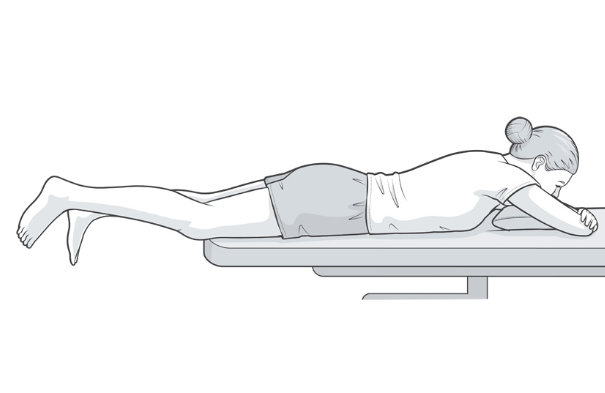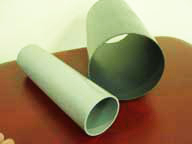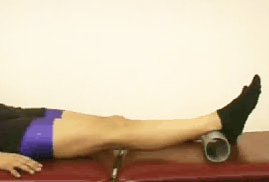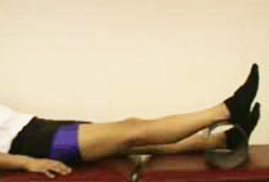Passive extension is the activity of assessing the amount of knee extension possible without muscle contraction, and a passive extension stretch is an exercise to keep the tissues mobile while the extensor muscles are being rehabilitated.
 Page updated April 2024 by Dr Sheila Strover (Clinical Editor)
Page updated April 2024 by Dr Sheila Strover (Clinical Editor)

Passive extension - such as in a prone hang - should be compared to a seated active extension.
Extension loss after injury or surgery
Failure to regain full extension after injury or surgery may be due to a weakness or inhibition of the extensor muscles (extension lag or quadriceps lag) or a mechanical cause such as adhesions or a physical obstruction (extension block).
By comparing the extension when seated and actively extending the knee, to prone and passively allowing the knee to extend, one can determine how much of the problem relates to a muscle weakness of inhibition and how much is due to a mechanical problem.
The clinician must determine which of the two possibilities is preventing the patient from fully extending the knee.
Arthrogenic muscle inhibition (AMI)
After knee injury or surgery it is very common for knee patients to complain that they simply cannot get their quads muscles to work ("fire") properly.
But it is important that extension is maintained, even if it has to be achieved passively in the first instance. The worry when a painful knee is voluntarily held slightly bent for a long time is that the capsule at the back of the knee can develop adhesions and then scar tissue between its folds and that the tendons of the hamstrings can also shorten.
-
Quote from peer-reviewed paper:
"....following trauma, surgery, progressive wear and tear or immobilization is a process known as arthrogenic muscle inhibition (AMI)....[which]....is caused by a change in the discharge of articular sensory receptors, and challenges to the spinal reflex pathways...."
Citation: Deepak S, Priti G; DScPT; Zishu T, Chetan P. The sitting [no-lexicon]active[/no-lexicon] and prone passive lag test: a validity study in a symptomatic knee population. J Phys Ther Sci. 2023 May;35(5):312-319. doi: 10.1589/jpts.35.312. Epub 2023 May 1. PMID: 37131358; PMCID: PMC10149295.
A simple passive extension stretch

Two differing widths of PVC tubing from the local building shop.

Resting the ankle on the smaller tube and relaxing the limb to help passively extend the knee.

The larger PVC tube creates greater passive force.
Cheap and easily available PVC tubes allow a simple passive stretch exercise.
Wider tubing increases the stretch. Placing an ankle weight on the knee during these passive stretch sessions can further improve the extension.
'Prone hangs' are also useful as a passive extension stretch.
-
Quote from peer reviewed paper:
"....Regaining full symmetrical extension is a primary goal of early-phase rehabilitation after ACL reconstruction...."
Citation: Delaloye JR, Murar J, Sánchez MG, Saithna A, Ouanezar H, Thaunat M, Vieira TD, Sonnery-Cottet B. How to Rapidly Abolish Knee Extension Deficit After Injury or Surgery: A Practice-Changing Video Pearl From the Scientific Anterior Cruciate Ligament Network International (SANTI) Study Group. Arthrosc Tech. 2018 May 7;7(6):e601-e605. doi: 10.1016/j.eats.2018.02.006. PMID: 30013901; PMCID: PMC6019855.
-
Quote from peer-reviewed paper:
"....Failure to regain full extension by 3 weeks after ACL reconstruction is an important predictive factor for subsequent cyclops syndrome...."
Citation: Delaloye JR, Murar J, Sánchez MG, Saithna A, Ouanezar H, Thaunat M, Vieira TD, Sonnery-Cottet B. How to Rapidly Abolish Knee Extension Deficit After Injury or Surgery: A Practice-Changing Video Pearl From the Scientific Anterior Cruciate Ligament Network International (SANTI) Study Group. Arthrosc Tech. 2018 May 7;7(6):e601-e605. doi: 10.1016/j.eats.2018.02.006. PMID: 30013901; PMCID: PMC6019855.
Forum discussions
- Extension deficit
A meniscus tear causes an extension deficit in this patient.